Management Accounting and Cost Analysis
VerifiedAdded on 2020/02/14
|18
|3165
|106
AI Summary
This assignment tasks students with preparing a report for the Board of Directors of Smart Looks Limited. The report must analyze the reasons behind discrepancies between actual and budgeted costs, attributing them to factors like resource overutilization and ineffective management systems. Recommendations are expected to focus on improving resource utilization through machinery implementation, reducing labor costs, and implementing robust forecasting strategies for better decision-making.
Contribute Materials
Your contribution can guide someone’s learning journey. Share your
documents today.
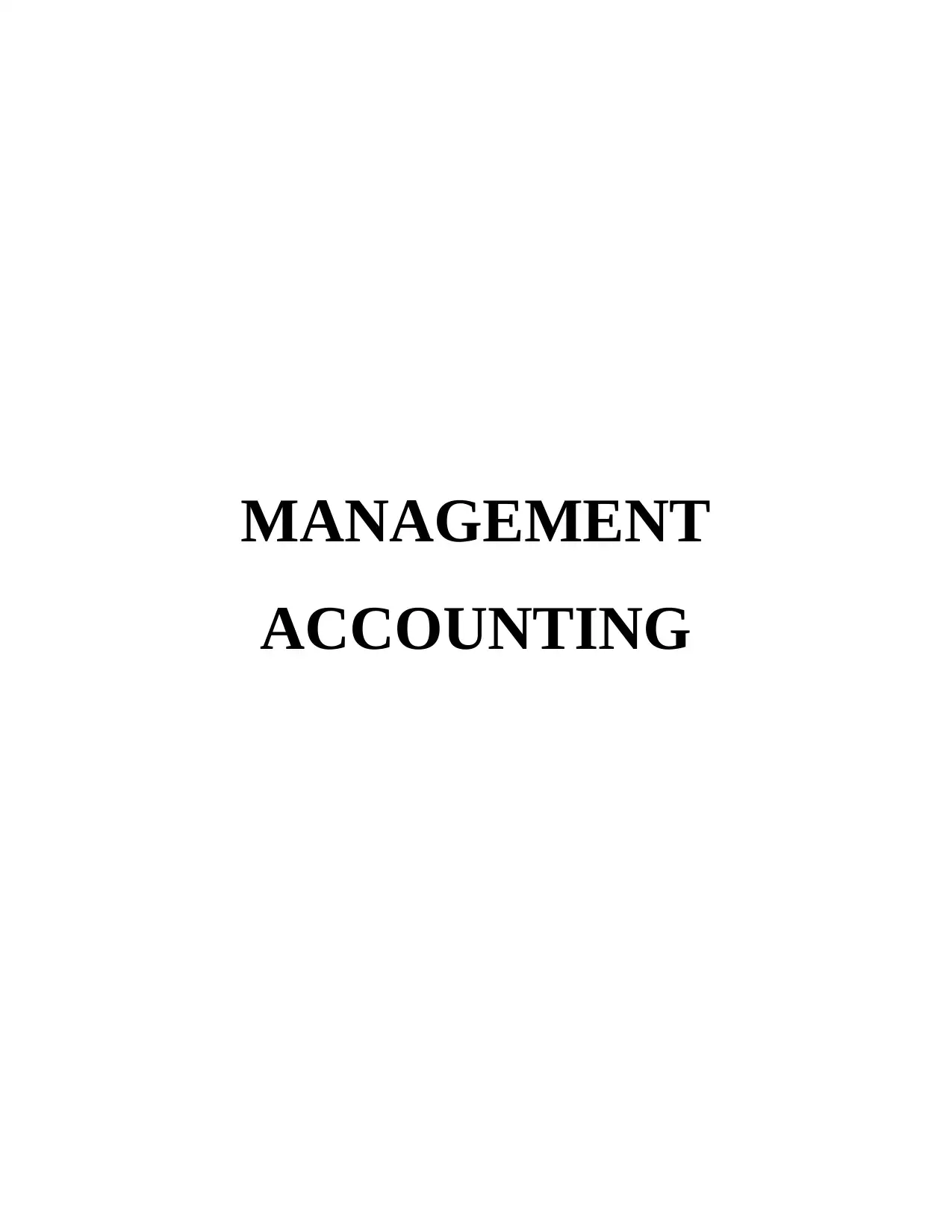
MANAGEMENT
ACCOUNTING
ACCOUNTING
Secure Best Marks with AI Grader
Need help grading? Try our AI Grader for instant feedback on your assignments.
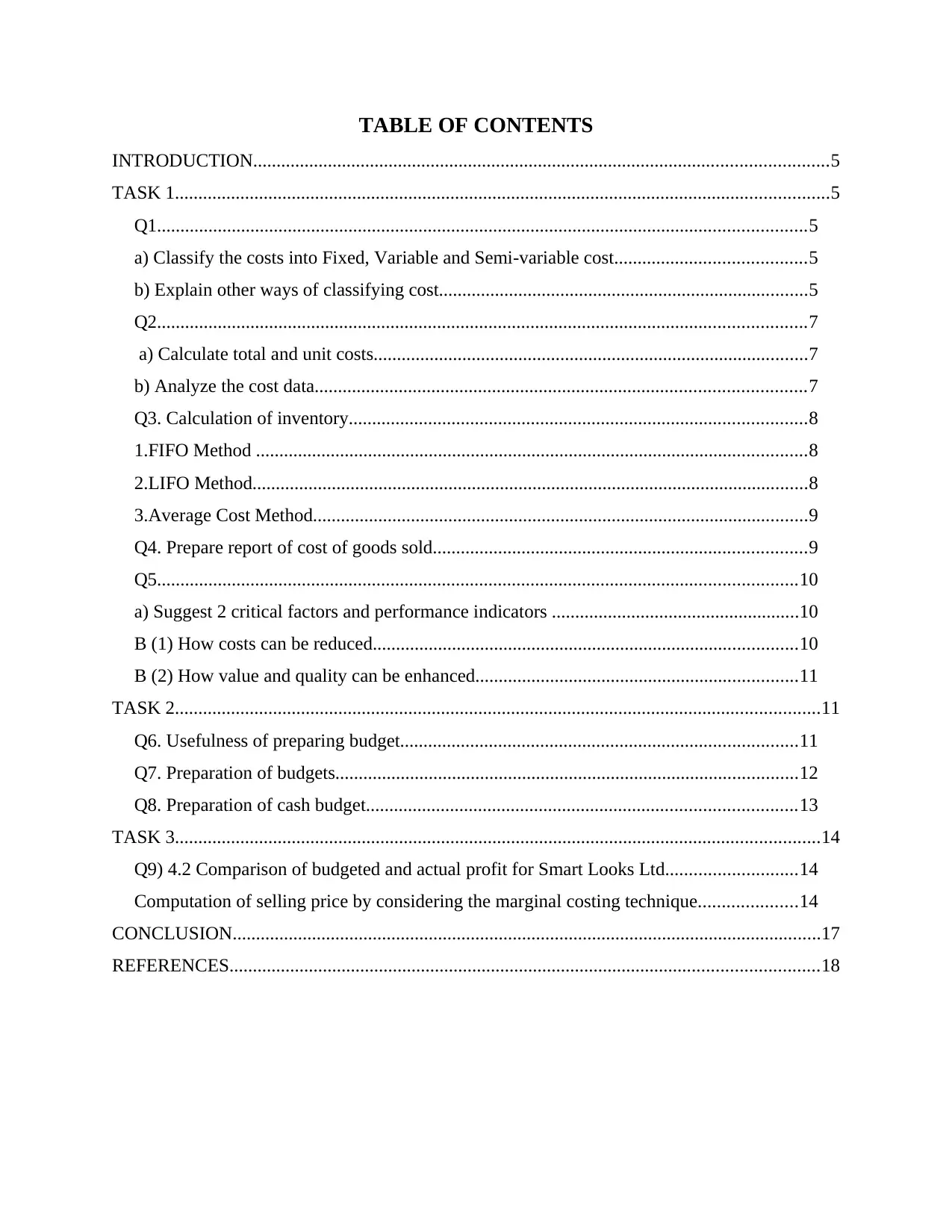
TABLE OF CONTENTS
INTRODUCTION...........................................................................................................................5
TASK 1............................................................................................................................................5
Q1...........................................................................................................................................5
a) Classify the costs into Fixed, Variable and Semi-variable cost.........................................5
b) Explain other ways of classifying cost...............................................................................5
Q2...........................................................................................................................................7
a) Calculate total and unit costs.............................................................................................7
b) Analyze the cost data.........................................................................................................7
Q3. Calculation of inventory..................................................................................................8
1.FIFO Method ......................................................................................................................8
2.LIFO Method.......................................................................................................................8
3.Average Cost Method..........................................................................................................9
Q4. Prepare report of cost of goods sold................................................................................9
Q5.........................................................................................................................................10
a) Suggest 2 critical factors and performance indicators .....................................................10
B (1) How costs can be reduced...........................................................................................10
B (2) How value and quality can be enhanced.....................................................................11
TASK 2..........................................................................................................................................11
Q6. Usefulness of preparing budget.....................................................................................11
Q7. Preparation of budgets...................................................................................................12
Q8. Preparation of cash budget............................................................................................13
TASK 3..........................................................................................................................................14
Q9) 4.2 Comparison of budgeted and actual profit for Smart Looks Ltd............................14
Computation of selling price by considering the marginal costing technique.....................14
CONCLUSION..............................................................................................................................17
REFERENCES..............................................................................................................................18
INTRODUCTION...........................................................................................................................5
TASK 1............................................................................................................................................5
Q1...........................................................................................................................................5
a) Classify the costs into Fixed, Variable and Semi-variable cost.........................................5
b) Explain other ways of classifying cost...............................................................................5
Q2...........................................................................................................................................7
a) Calculate total and unit costs.............................................................................................7
b) Analyze the cost data.........................................................................................................7
Q3. Calculation of inventory..................................................................................................8
1.FIFO Method ......................................................................................................................8
2.LIFO Method.......................................................................................................................8
3.Average Cost Method..........................................................................................................9
Q4. Prepare report of cost of goods sold................................................................................9
Q5.........................................................................................................................................10
a) Suggest 2 critical factors and performance indicators .....................................................10
B (1) How costs can be reduced...........................................................................................10
B (2) How value and quality can be enhanced.....................................................................11
TASK 2..........................................................................................................................................11
Q6. Usefulness of preparing budget.....................................................................................11
Q7. Preparation of budgets...................................................................................................12
Q8. Preparation of cash budget............................................................................................13
TASK 3..........................................................................................................................................14
Q9) 4.2 Comparison of budgeted and actual profit for Smart Looks Ltd............................14
Computation of selling price by considering the marginal costing technique.....................14
CONCLUSION..............................................................................................................................17
REFERENCES..............................................................................................................................18
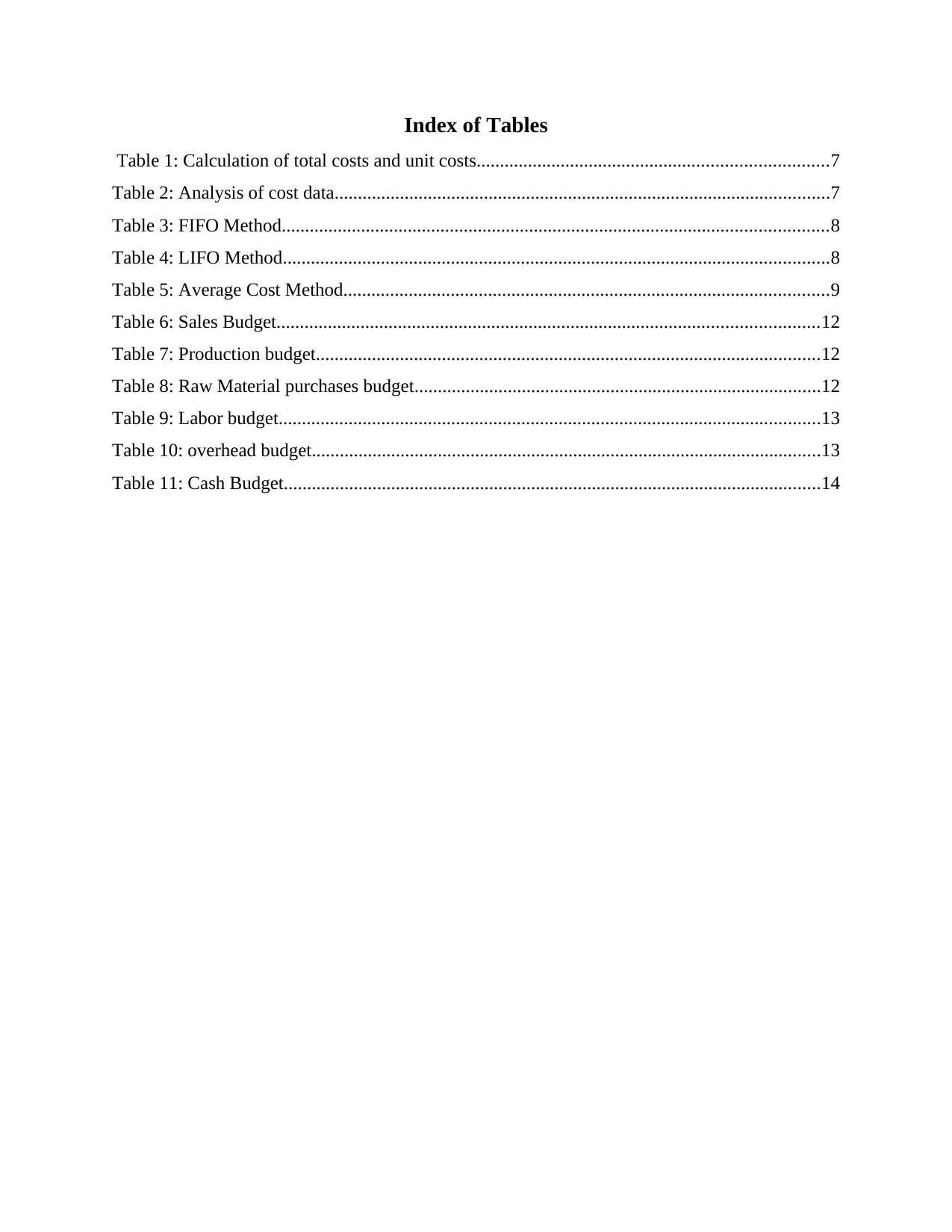
Index of Tables
Table 1: Calculation of total costs and unit costs...........................................................................7
Table 2: Analysis of cost data..........................................................................................................7
Table 3: FIFO Method.....................................................................................................................8
Table 4: LIFO Method.....................................................................................................................8
Table 5: Average Cost Method........................................................................................................9
Table 6: Sales Budget....................................................................................................................12
Table 7: Production budget............................................................................................................12
Table 8: Raw Material purchases budget.......................................................................................12
Table 9: Labor budget....................................................................................................................13
Table 10: overhead budget.............................................................................................................13
Table 11: Cash Budget...................................................................................................................14
Table 1: Calculation of total costs and unit costs...........................................................................7
Table 2: Analysis of cost data..........................................................................................................7
Table 3: FIFO Method.....................................................................................................................8
Table 4: LIFO Method.....................................................................................................................8
Table 5: Average Cost Method........................................................................................................9
Table 6: Sales Budget....................................................................................................................12
Table 7: Production budget............................................................................................................12
Table 8: Raw Material purchases budget.......................................................................................12
Table 9: Labor budget....................................................................................................................13
Table 10: overhead budget.............................................................................................................13
Table 11: Cash Budget...................................................................................................................14
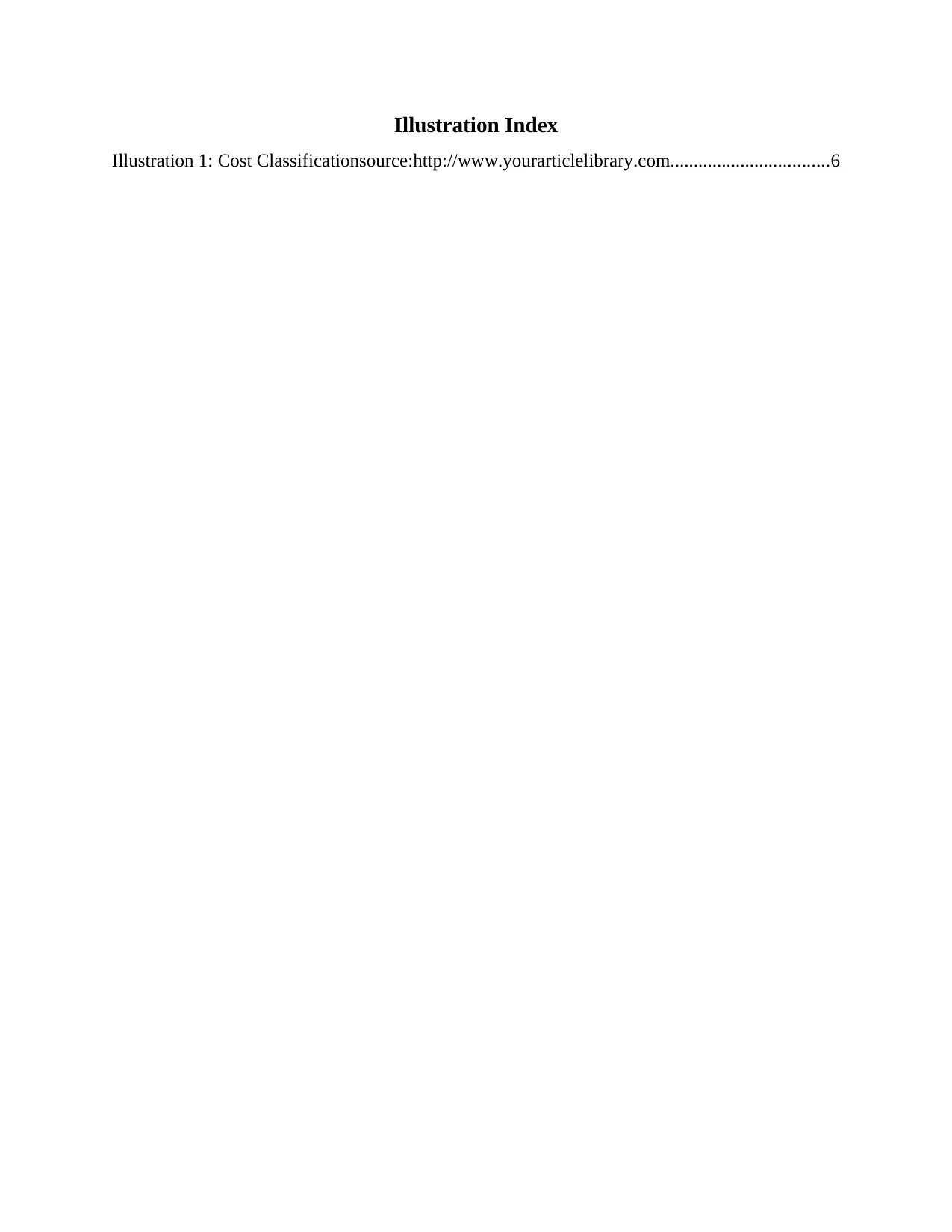
Illustration Index
Illustration 1: Cost Classificationsource:http://www.yourarticlelibrary.com..................................6
Illustration 1: Cost Classificationsource:http://www.yourarticlelibrary.com..................................6
Secure Best Marks with AI Grader
Need help grading? Try our AI Grader for instant feedback on your assignments.
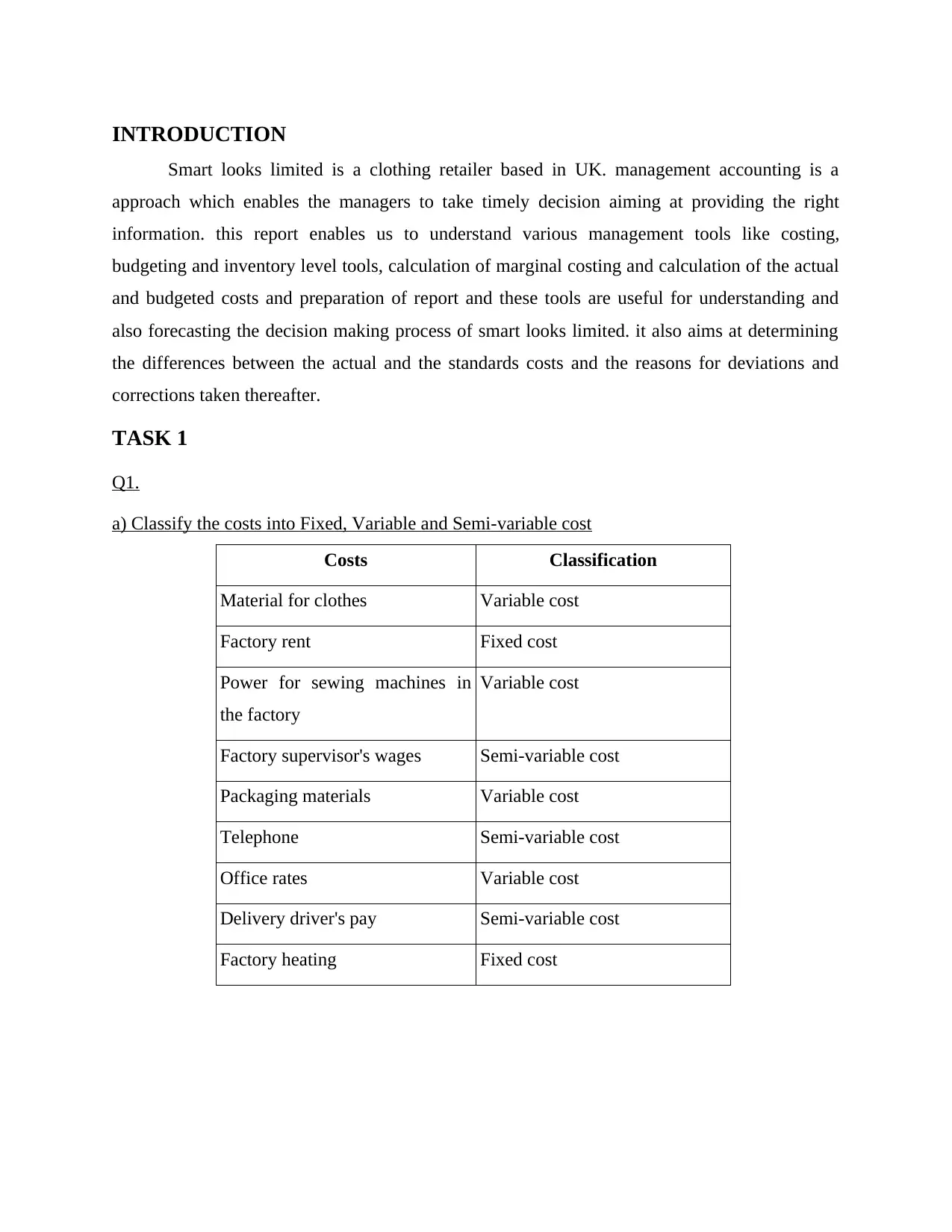
INTRODUCTION
Smart looks limited is a clothing retailer based in UK. management accounting is a
approach which enables the managers to take timely decision aiming at providing the right
information. this report enables us to understand various management tools like costing,
budgeting and inventory level tools, calculation of marginal costing and calculation of the actual
and budgeted costs and preparation of report and these tools are useful for understanding and
also forecasting the decision making process of smart looks limited. it also aims at determining
the differences between the actual and the standards costs and the reasons for deviations and
corrections taken thereafter.
TASK 1
Q1.
a) Classify the costs into Fixed, Variable and Semi-variable cost
Costs Classification
Material for clothes Variable cost
Factory rent Fixed cost
Power for sewing machines in
the factory
Variable cost
Factory supervisor's wages Semi-variable cost
Packaging materials Variable cost
Telephone Semi-variable cost
Office rates Variable cost
Delivery driver's pay Semi-variable cost
Factory heating Fixed cost
Smart looks limited is a clothing retailer based in UK. management accounting is a
approach which enables the managers to take timely decision aiming at providing the right
information. this report enables us to understand various management tools like costing,
budgeting and inventory level tools, calculation of marginal costing and calculation of the actual
and budgeted costs and preparation of report and these tools are useful for understanding and
also forecasting the decision making process of smart looks limited. it also aims at determining
the differences between the actual and the standards costs and the reasons for deviations and
corrections taken thereafter.
TASK 1
Q1.
a) Classify the costs into Fixed, Variable and Semi-variable cost
Costs Classification
Material for clothes Variable cost
Factory rent Fixed cost
Power for sewing machines in
the factory
Variable cost
Factory supervisor's wages Semi-variable cost
Packaging materials Variable cost
Telephone Semi-variable cost
Office rates Variable cost
Delivery driver's pay Semi-variable cost
Factory heating Fixed cost

b) Explain other ways of classifying cost
The other ways of classifying costs are:
Illustration 1: Cost Classificationsource:http://www.yourarticlelibrary.com
Direct Costs- Direct costs are the costs which are directly attributable to a particular
product such as Direct Material, direct labor etc.
Indirect Costs- These costs are not directly attributable to a particular product such as
Factory overhead etc (Zimmerman,2011).
The other ways of classifying costs are:
Illustration 1: Cost Classificationsource:http://www.yourarticlelibrary.com
Direct Costs- Direct costs are the costs which are directly attributable to a particular
product such as Direct Material, direct labor etc.
Indirect Costs- These costs are not directly attributable to a particular product such as
Factory overhead etc (Zimmerman,2011).

Product Costs- These costs can be identifies to a individual product. It is the cost which is
incurred when we create a product. Examples are direct material, Factory overhead etc.
Period Costs- These costs cannot be identifies on the individual product and these cost
continues for a period of time like depreciation, advertising expenses etc.
Controllable costs- Controllable costs are the costs can be controlled by the management
like direct expenses, labor etc.
Sunk Costs- As the name suggests, these are the costs which cannot be recovered as they
have already been incurred and thus they are not even considered for decision making.
Example can the cost incurred on training (Pitkänen and Lukka, 2011).
Opportunity Costs- When once alternative is chosen over the another and the cost so
foregone is opportunity costs. These are costs which are considered for decision making.
Q2.
a) Calculate total and unit costs
Table 1: Calculation of total costs and unit costs
15000 units 20000 units 25000 units
Material £5 £75000 £100000 £125000
Labor £6 £90000 £120000 £150000
Total fixed costs £50000 £50000 £50000
Unit Costs ( Total cost /
number of units)
£14.33 £13.5 £13
Material £5 £75000 £100000 £125000
Labor £6 £90000 £120000 £150000
Total fixed costs £50000 £50000 £50000
Total Costs £215000 £270000 £325000
incurred when we create a product. Examples are direct material, Factory overhead etc.
Period Costs- These costs cannot be identifies on the individual product and these cost
continues for a period of time like depreciation, advertising expenses etc.
Controllable costs- Controllable costs are the costs can be controlled by the management
like direct expenses, labor etc.
Sunk Costs- As the name suggests, these are the costs which cannot be recovered as they
have already been incurred and thus they are not even considered for decision making.
Example can the cost incurred on training (Pitkänen and Lukka, 2011).
Opportunity Costs- When once alternative is chosen over the another and the cost so
foregone is opportunity costs. These are costs which are considered for decision making.
Q2.
a) Calculate total and unit costs
Table 1: Calculation of total costs and unit costs
15000 units 20000 units 25000 units
Material £5 £75000 £100000 £125000
Labor £6 £90000 £120000 £150000
Total fixed costs £50000 £50000 £50000
Unit Costs ( Total cost /
number of units)
£14.33 £13.5 £13
Material £5 £75000 £100000 £125000
Labor £6 £90000 £120000 £150000
Total fixed costs £50000 £50000 £50000
Total Costs £215000 £270000 £325000
Paraphrase This Document
Need a fresh take? Get an instant paraphrase of this document with our AI Paraphraser
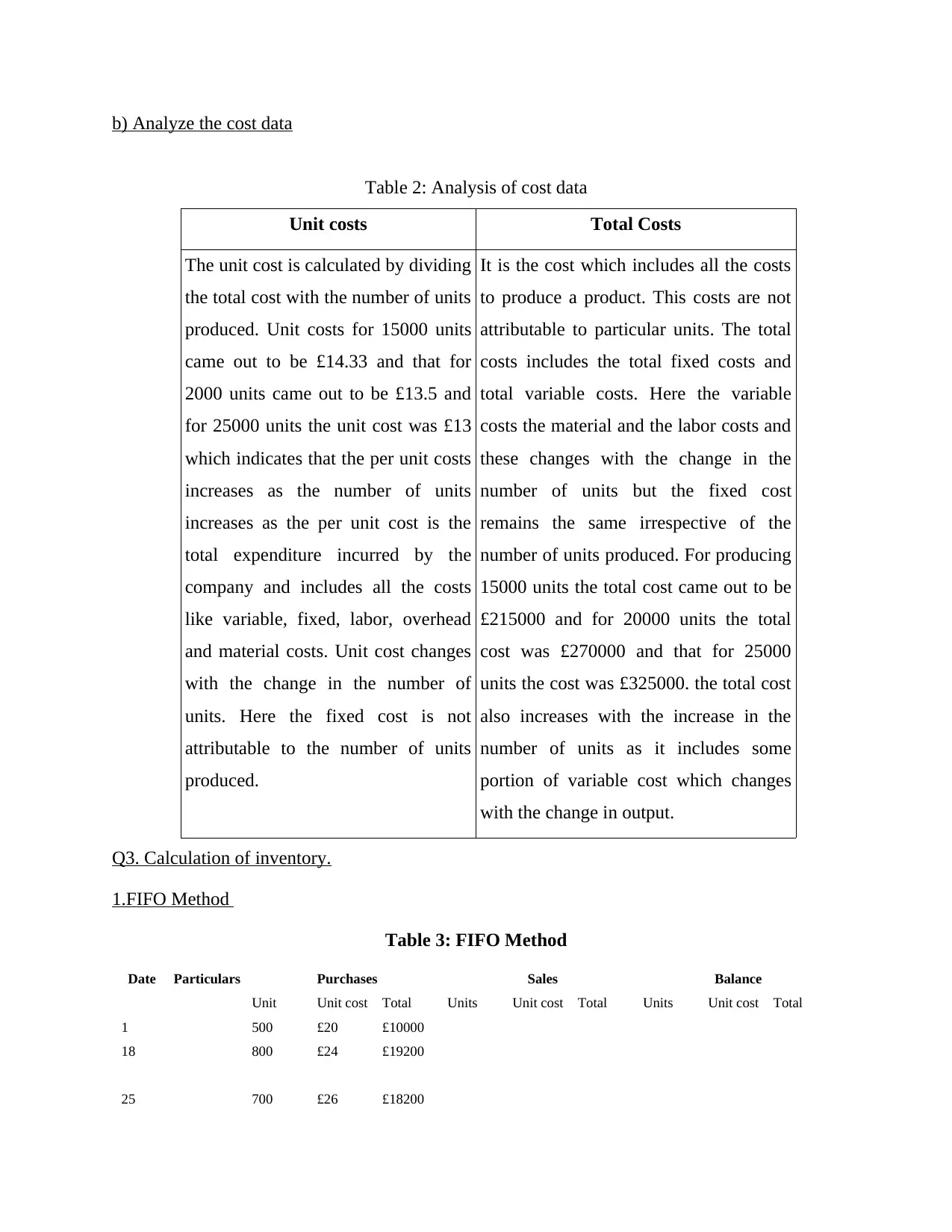
b) Analyze the cost data
Table 2: Analysis of cost data
Unit costs Total Costs
The unit cost is calculated by dividing
the total cost with the number of units
produced. Unit costs for 15000 units
came out to be £14.33 and that for
2000 units came out to be £13.5 and
for 25000 units the unit cost was £13
which indicates that the per unit costs
increases as the number of units
increases as the per unit cost is the
total expenditure incurred by the
company and includes all the costs
like variable, fixed, labor, overhead
and material costs. Unit cost changes
with the change in the number of
units. Here the fixed cost is not
attributable to the number of units
produced.
It is the cost which includes all the costs
to produce a product. This costs are not
attributable to particular units. The total
costs includes the total fixed costs and
total variable costs. Here the variable
costs the material and the labor costs and
these changes with the change in the
number of units but the fixed cost
remains the same irrespective of the
number of units produced. For producing
15000 units the total cost came out to be
£215000 and for 20000 units the total
cost was £270000 and that for 25000
units the cost was £325000. the total cost
also increases with the increase in the
number of units as it includes some
portion of variable cost which changes
with the change in output.
Q3. Calculation of inventory.
1.FIFO Method
Table 3: FIFO Method
Date Particulars Purchases Sales Balance
Unit Unit cost Total Units Unit cost Total Units Unit cost Total
1 500 £20 £10000
18 800 £24 £19200
25 700 £26 £18200
Table 2: Analysis of cost data
Unit costs Total Costs
The unit cost is calculated by dividing
the total cost with the number of units
produced. Unit costs for 15000 units
came out to be £14.33 and that for
2000 units came out to be £13.5 and
for 25000 units the unit cost was £13
which indicates that the per unit costs
increases as the number of units
increases as the per unit cost is the
total expenditure incurred by the
company and includes all the costs
like variable, fixed, labor, overhead
and material costs. Unit cost changes
with the change in the number of
units. Here the fixed cost is not
attributable to the number of units
produced.
It is the cost which includes all the costs
to produce a product. This costs are not
attributable to particular units. The total
costs includes the total fixed costs and
total variable costs. Here the variable
costs the material and the labor costs and
these changes with the change in the
number of units but the fixed cost
remains the same irrespective of the
number of units produced. For producing
15000 units the total cost came out to be
£215000 and for 20000 units the total
cost was £270000 and that for 25000
units the cost was £325000. the total cost
also increases with the increase in the
number of units as it includes some
portion of variable cost which changes
with the change in output.
Q3. Calculation of inventory.
1.FIFO Method
Table 3: FIFO Method
Date Particulars Purchases Sales Balance
Unit Unit cost Total Units Unit cost Total Units Unit cost Total
1 500 £20 £10000
18 800 £24 £19200
25 700 £26 £18200
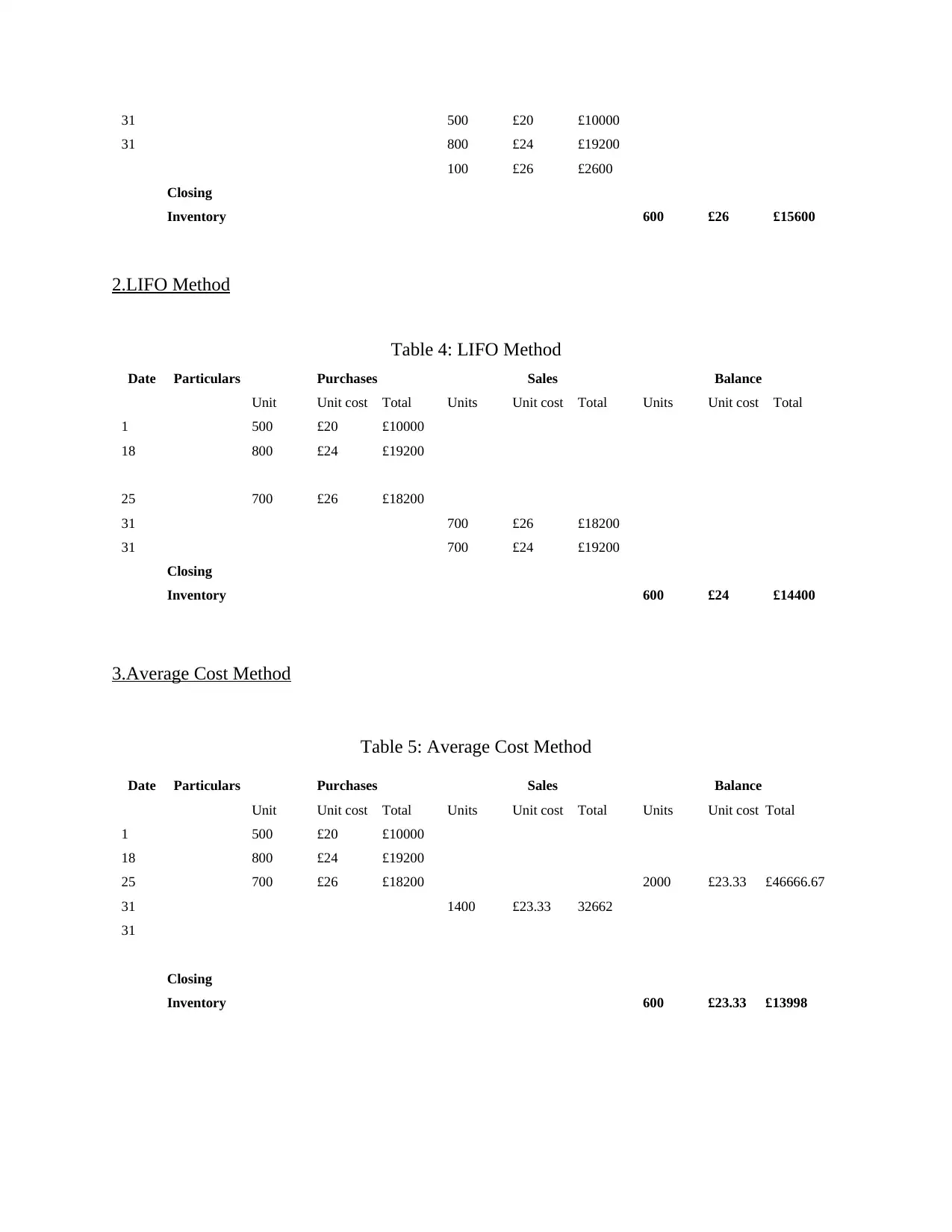
31 500 £20 £10000
31 800 £24 £19200
100 £26 £2600
Closing
Inventory 600 £26 £15600
2.LIFO Method
Table 4: LIFO Method
Date Particulars Purchases Sales Balance
Unit Unit cost Total Units Unit cost Total Units Unit cost Total
1 500 £20 £10000
18 800 £24 £19200
25 700 £26 £18200
31 700 £26 £18200
31 700 £24 £19200
Closing
Inventory 600 £24 £14400
3.Average Cost Method
Table 5: Average Cost Method
Date Particulars Purchases Sales Balance
Unit Unit cost Total Units Unit cost Total Units Unit cost Total
1 500 £20 £10000
18 800 £24 £19200
25 700 £26 £18200 2000 £23.33 £46666.67
31 1400 £23.33 32662
31
Closing
Inventory 600 £23.33 £13998
31 800 £24 £19200
100 £26 £2600
Closing
Inventory 600 £26 £15600
2.LIFO Method
Table 4: LIFO Method
Date Particulars Purchases Sales Balance
Unit Unit cost Total Units Unit cost Total Units Unit cost Total
1 500 £20 £10000
18 800 £24 £19200
25 700 £26 £18200
31 700 £26 £18200
31 700 £24 £19200
Closing
Inventory 600 £24 £14400
3.Average Cost Method
Table 5: Average Cost Method
Date Particulars Purchases Sales Balance
Unit Unit cost Total Units Unit cost Total Units Unit cost Total
1 500 £20 £10000
18 800 £24 £19200
25 700 £26 £18200 2000 £23.33 £46666.67
31 1400 £23.33 32662
31
Closing
Inventory 600 £23.33 £13998
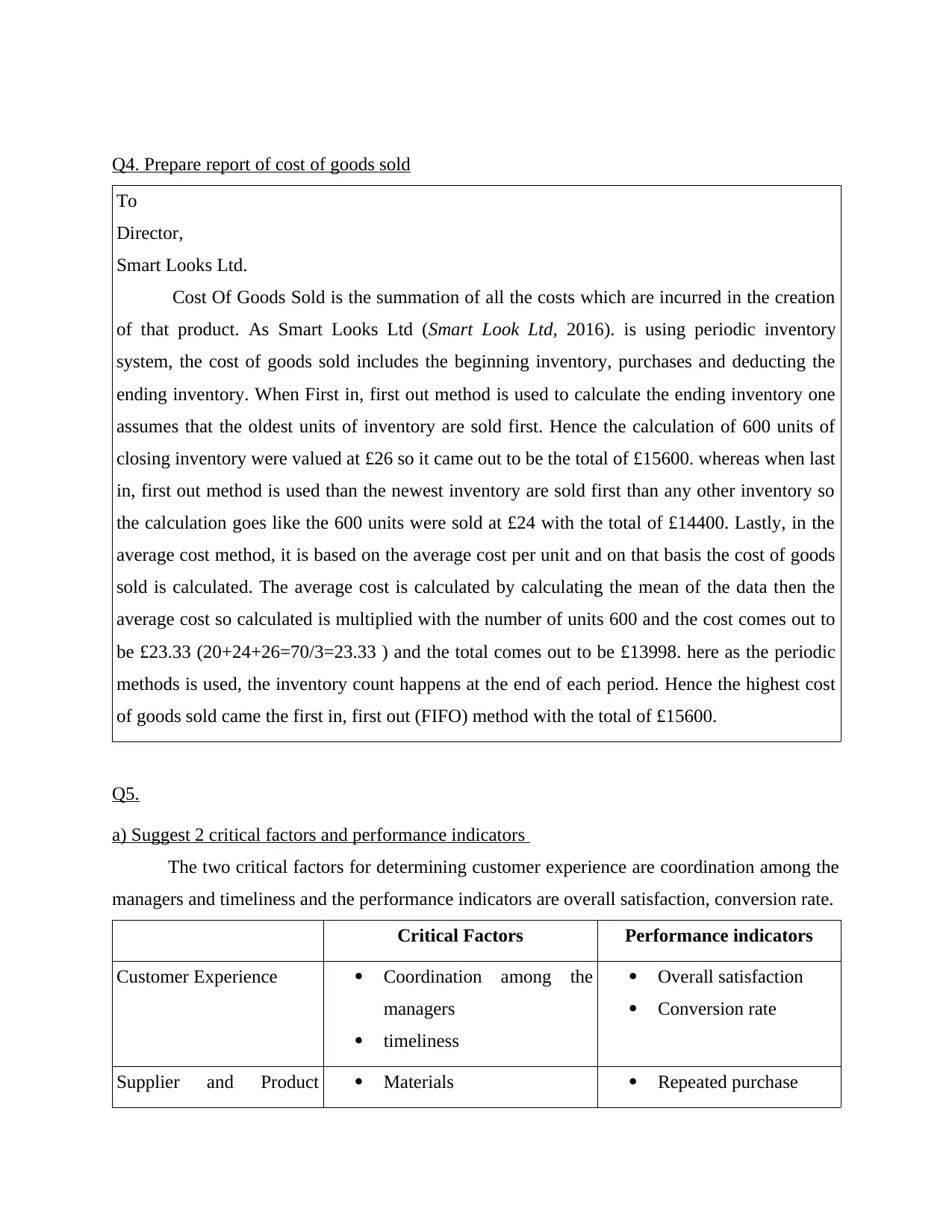
Q4. Prepare report of cost of goods sold
To
Director,
Smart Looks Ltd.
Cost Of Goods Sold is the summation of all the costs which are incurred in the creation
of that product. As Smart Looks Ltd (Smart Look Ltd, 2016). is using periodic inventory
system, the cost of goods sold includes the beginning inventory, purchases and deducting the
ending inventory. When First in, first out method is used to calculate the ending inventory one
assumes that the oldest units of inventory are sold first. Hence the calculation of 600 units of
closing inventory were valued at £26 so it came out to be the total of £15600. whereas when last
in, first out method is used than the newest inventory are sold first than any other inventory so
the calculation goes like the 600 units were sold at £24 with the total of £14400. Lastly, in the
average cost method, it is based on the average cost per unit and on that basis the cost of goods
sold is calculated. The average cost is calculated by calculating the mean of the data then the
average cost so calculated is multiplied with the number of units 600 and the cost comes out to
be £23.33 (20+24+26=70/3=23.33 ) and the total comes out to be £13998. here as the periodic
methods is used, the inventory count happens at the end of each period. Hence the highest cost
of goods sold came the first in, first out (FIFO) method with the total of £15600.
Q5.
a) Suggest 2 critical factors and performance indicators
The two critical factors for determining customer experience are coordination among the
managers and timeliness and the performance indicators are overall satisfaction, conversion rate.
Critical Factors Performance indicators
Customer Experience Coordination among the
managers
timeliness
Overall satisfaction
Conversion rate
Supplier and Product Materials Repeated purchase
To
Director,
Smart Looks Ltd.
Cost Of Goods Sold is the summation of all the costs which are incurred in the creation
of that product. As Smart Looks Ltd (Smart Look Ltd, 2016). is using periodic inventory
system, the cost of goods sold includes the beginning inventory, purchases and deducting the
ending inventory. When First in, first out method is used to calculate the ending inventory one
assumes that the oldest units of inventory are sold first. Hence the calculation of 600 units of
closing inventory were valued at £26 so it came out to be the total of £15600. whereas when last
in, first out method is used than the newest inventory are sold first than any other inventory so
the calculation goes like the 600 units were sold at £24 with the total of £14400. Lastly, in the
average cost method, it is based on the average cost per unit and on that basis the cost of goods
sold is calculated. The average cost is calculated by calculating the mean of the data then the
average cost so calculated is multiplied with the number of units 600 and the cost comes out to
be £23.33 (20+24+26=70/3=23.33 ) and the total comes out to be £13998. here as the periodic
methods is used, the inventory count happens at the end of each period. Hence the highest cost
of goods sold came the first in, first out (FIFO) method with the total of £15600.
Q5.
a) Suggest 2 critical factors and performance indicators
The two critical factors for determining customer experience are coordination among the
managers and timeliness and the performance indicators are overall satisfaction, conversion rate.
Critical Factors Performance indicators
Customer Experience Coordination among the
managers
timeliness
Overall satisfaction
Conversion rate
Supplier and Product Materials Repeated purchase
Secure Best Marks with AI Grader
Need help grading? Try our AI Grader for instant feedback on your assignments.
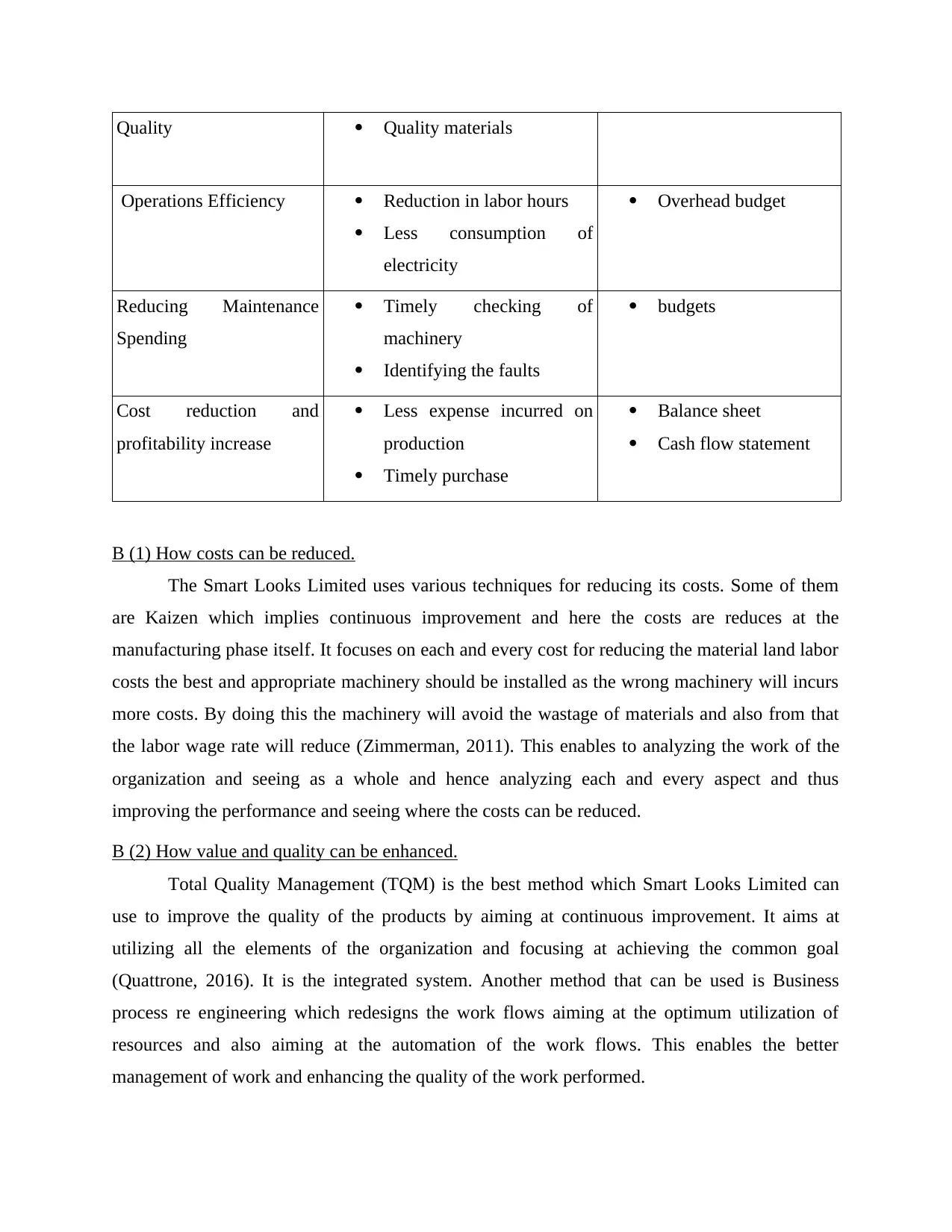
Quality Quality materials
Operations Efficiency Reduction in labor hours
Less consumption of
electricity
Overhead budget
Reducing Maintenance
Spending
Timely checking of
machinery
Identifying the faults
budgets
Cost reduction and
profitability increase
Less expense incurred on
production
Timely purchase
Balance sheet
Cash flow statement
B (1) How costs can be reduced.
The Smart Looks Limited uses various techniques for reducing its costs. Some of them
are Kaizen which implies continuous improvement and here the costs are reduces at the
manufacturing phase itself. It focuses on each and every cost for reducing the material land labor
costs the best and appropriate machinery should be installed as the wrong machinery will incurs
more costs. By doing this the machinery will avoid the wastage of materials and also from that
the labor wage rate will reduce (Zimmerman, 2011). This enables to analyzing the work of the
organization and seeing as a whole and hence analyzing each and every aspect and thus
improving the performance and seeing where the costs can be reduced.
B (2) How value and quality can be enhanced.
Total Quality Management (TQM) is the best method which Smart Looks Limited can
use to improve the quality of the products by aiming at continuous improvement. It aims at
utilizing all the elements of the organization and focusing at achieving the common goal
(Quattrone, 2016). It is the integrated system. Another method that can be used is Business
process re engineering which redesigns the work flows aiming at the optimum utilization of
resources and also aiming at the automation of the work flows. This enables the better
management of work and enhancing the quality of the work performed.
Operations Efficiency Reduction in labor hours
Less consumption of
electricity
Overhead budget
Reducing Maintenance
Spending
Timely checking of
machinery
Identifying the faults
budgets
Cost reduction and
profitability increase
Less expense incurred on
production
Timely purchase
Balance sheet
Cash flow statement
B (1) How costs can be reduced.
The Smart Looks Limited uses various techniques for reducing its costs. Some of them
are Kaizen which implies continuous improvement and here the costs are reduces at the
manufacturing phase itself. It focuses on each and every cost for reducing the material land labor
costs the best and appropriate machinery should be installed as the wrong machinery will incurs
more costs. By doing this the machinery will avoid the wastage of materials and also from that
the labor wage rate will reduce (Zimmerman, 2011). This enables to analyzing the work of the
organization and seeing as a whole and hence analyzing each and every aspect and thus
improving the performance and seeing where the costs can be reduced.
B (2) How value and quality can be enhanced.
Total Quality Management (TQM) is the best method which Smart Looks Limited can
use to improve the quality of the products by aiming at continuous improvement. It aims at
utilizing all the elements of the organization and focusing at achieving the common goal
(Quattrone, 2016). It is the integrated system. Another method that can be used is Business
process re engineering which redesigns the work flows aiming at the optimum utilization of
resources and also aiming at the automation of the work flows. This enables the better
management of work and enhancing the quality of the work performed.
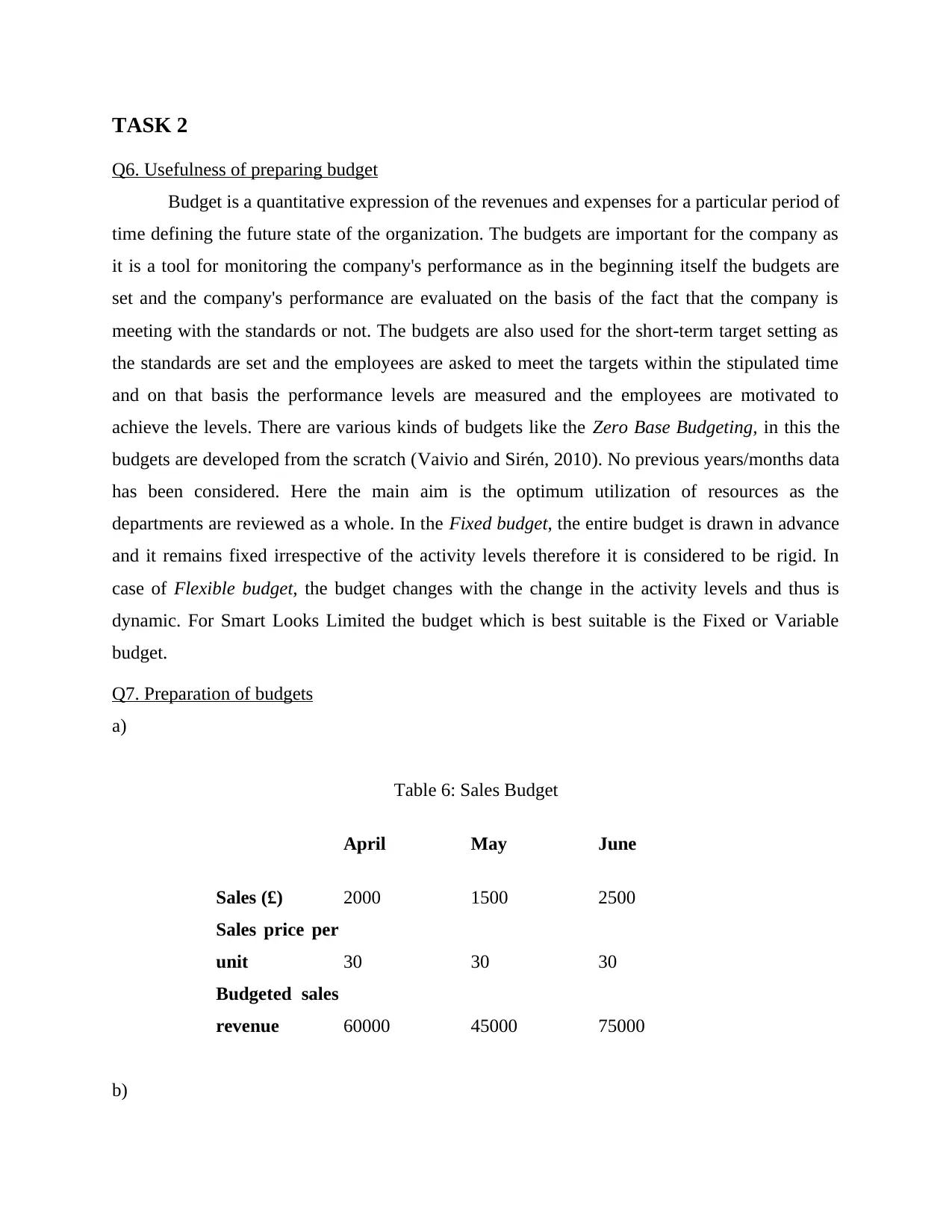
TASK 2
Q6. Usefulness of preparing budget
Budget is a quantitative expression of the revenues and expenses for a particular period of
time defining the future state of the organization. The budgets are important for the company as
it is a tool for monitoring the company's performance as in the beginning itself the budgets are
set and the company's performance are evaluated on the basis of the fact that the company is
meeting with the standards or not. The budgets are also used for the short-term target setting as
the standards are set and the employees are asked to meet the targets within the stipulated time
and on that basis the performance levels are measured and the employees are motivated to
achieve the levels. There are various kinds of budgets like the Zero Base Budgeting, in this the
budgets are developed from the scratch (Vaivio and Sirén, 2010). No previous years/months data
has been considered. Here the main aim is the optimum utilization of resources as the
departments are reviewed as a whole. In the Fixed budget, the entire budget is drawn in advance
and it remains fixed irrespective of the activity levels therefore it is considered to be rigid. In
case of Flexible budget, the budget changes with the change in the activity levels and thus is
dynamic. For Smart Looks Limited the budget which is best suitable is the Fixed or Variable
budget.
Q7. Preparation of budgets
a)
Table 6: Sales Budget
April May June
Sales (£) 2000 1500 2500
Sales price per
unit 30 30 30
Budgeted sales
revenue 60000 45000 75000
b)
Q6. Usefulness of preparing budget
Budget is a quantitative expression of the revenues and expenses for a particular period of
time defining the future state of the organization. The budgets are important for the company as
it is a tool for monitoring the company's performance as in the beginning itself the budgets are
set and the company's performance are evaluated on the basis of the fact that the company is
meeting with the standards or not. The budgets are also used for the short-term target setting as
the standards are set and the employees are asked to meet the targets within the stipulated time
and on that basis the performance levels are measured and the employees are motivated to
achieve the levels. There are various kinds of budgets like the Zero Base Budgeting, in this the
budgets are developed from the scratch (Vaivio and Sirén, 2010). No previous years/months data
has been considered. Here the main aim is the optimum utilization of resources as the
departments are reviewed as a whole. In the Fixed budget, the entire budget is drawn in advance
and it remains fixed irrespective of the activity levels therefore it is considered to be rigid. In
case of Flexible budget, the budget changes with the change in the activity levels and thus is
dynamic. For Smart Looks Limited the budget which is best suitable is the Fixed or Variable
budget.
Q7. Preparation of budgets
a)
Table 6: Sales Budget
April May June
Sales (£) 2000 1500 2500
Sales price per
unit 30 30 30
Budgeted sales
revenue 60000 45000 75000
b)
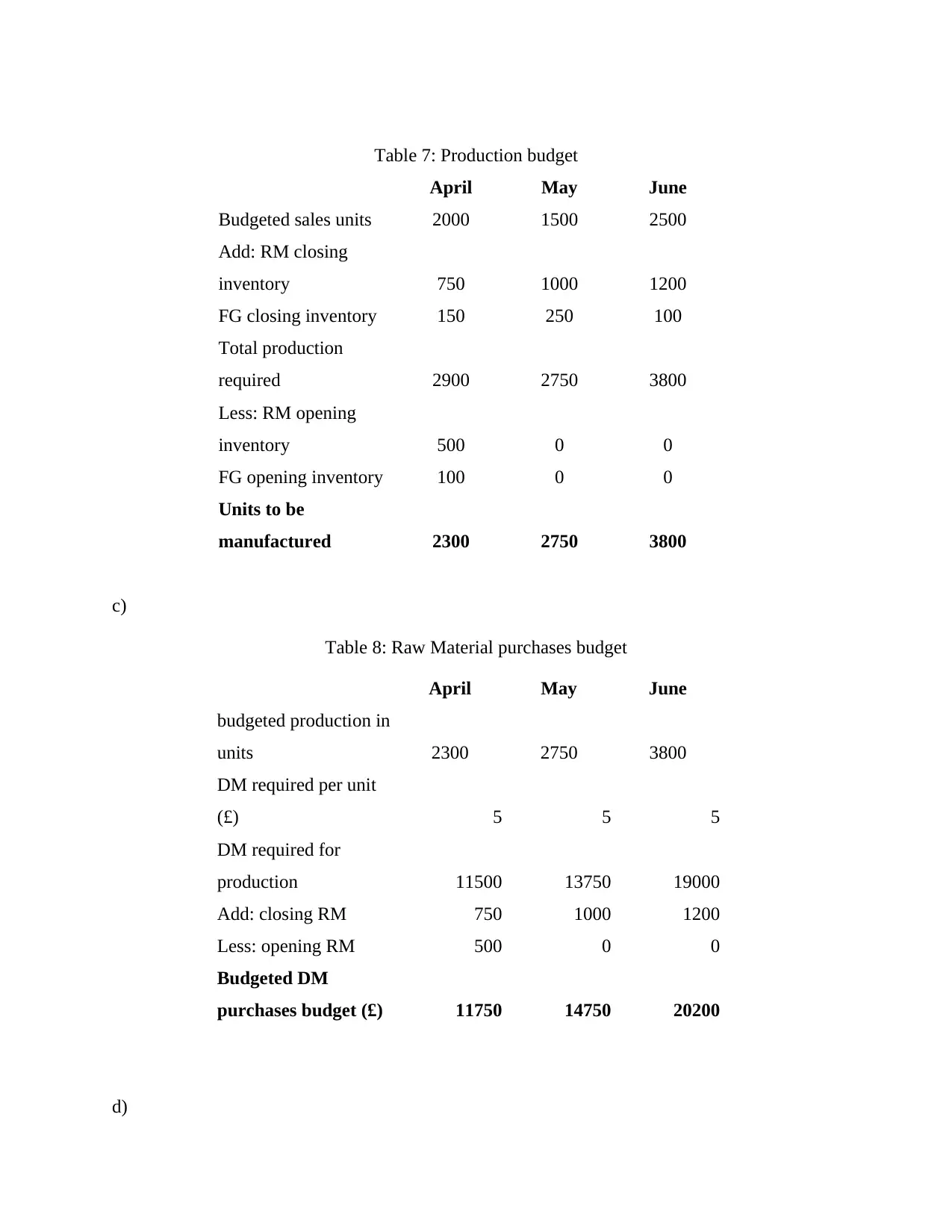
Table 7: Production budget
April May June
Budgeted sales units 2000 1500 2500
Add: RM closing
inventory 750 1000 1200
FG closing inventory 150 250 100
Total production
required 2900 2750 3800
Less: RM opening
inventory 500 0 0
FG opening inventory 100 0 0
Units to be
manufactured 2300 2750 3800
c)
Table 8: Raw Material purchases budget
April May June
budgeted production in
units 2300 2750 3800
DM required per unit
(£) 5 5 5
DM required for
production 11500 13750 19000
Add: closing RM 750 1000 1200
Less: opening RM 500 0 0
Budgeted DM
purchases budget (£) 11750 14750 20200
d)
April May June
Budgeted sales units 2000 1500 2500
Add: RM closing
inventory 750 1000 1200
FG closing inventory 150 250 100
Total production
required 2900 2750 3800
Less: RM opening
inventory 500 0 0
FG opening inventory 100 0 0
Units to be
manufactured 2300 2750 3800
c)
Table 8: Raw Material purchases budget
April May June
budgeted production in
units 2300 2750 3800
DM required per unit
(£) 5 5 5
DM required for
production 11500 13750 19000
Add: closing RM 750 1000 1200
Less: opening RM 500 0 0
Budgeted DM
purchases budget (£) 11750 14750 20200
d)
Paraphrase This Document
Need a fresh take? Get an instant paraphrase of this document with our AI Paraphraser
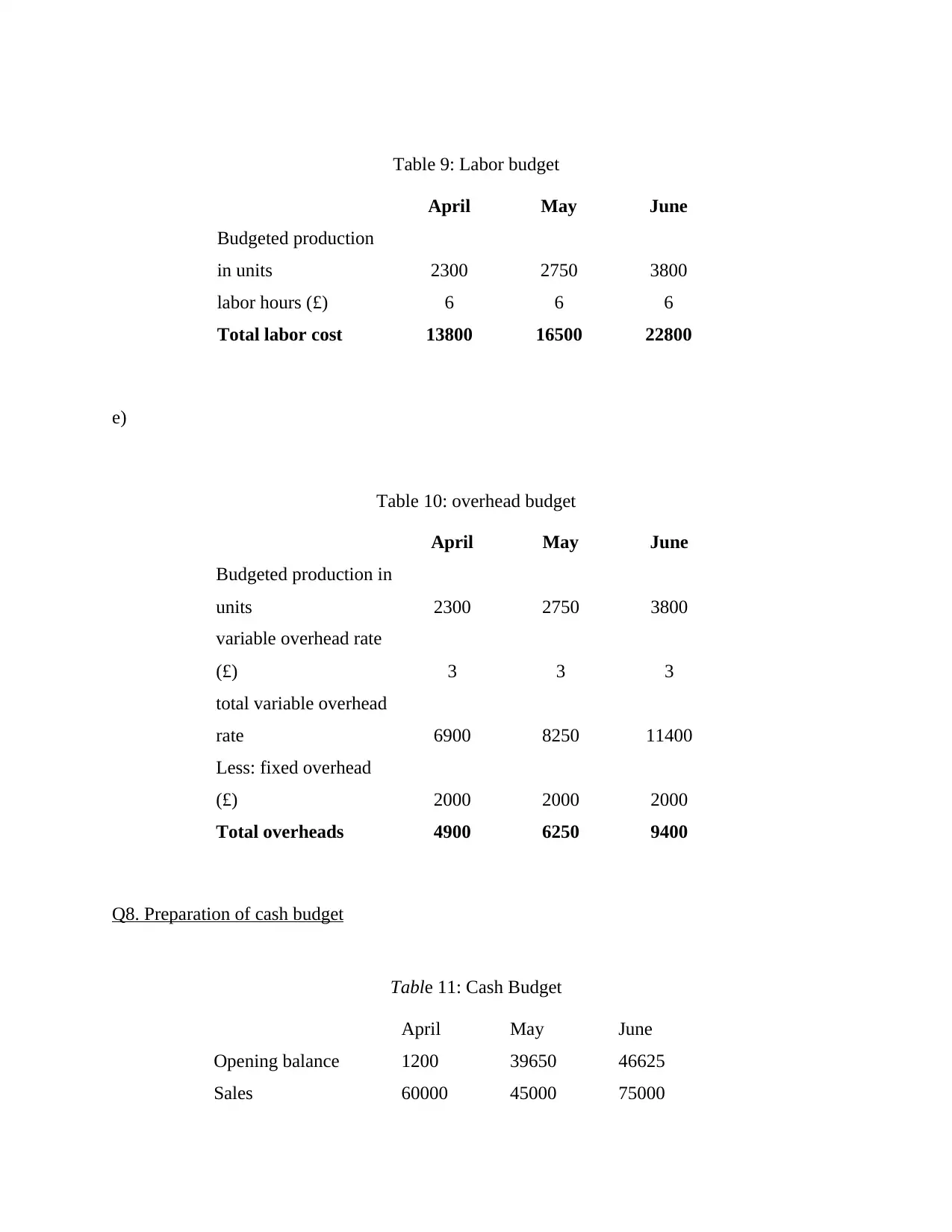
Table 9: Labor budget
April May June
Budgeted production
in units 2300 2750 3800
labor hours (£) 6 6 6
Total labor cost 13800 16500 22800
e)
Table 10: overhead budget
April May June
Budgeted production in
units 2300 2750 3800
variable overhead rate
(£) 3 3 3
total variable overhead
rate 6900 8250 11400
Less: fixed overhead
(£) 2000 2000 2000
Total overheads 4900 6250 9400
Q8. Preparation of cash budget
Table 11: Cash Budget
April May June
Opening balance 1200 39650 46625
Sales 60000 45000 75000
April May June
Budgeted production
in units 2300 2750 3800
labor hours (£) 6 6 6
Total labor cost 13800 16500 22800
e)
Table 10: overhead budget
April May June
Budgeted production in
units 2300 2750 3800
variable overhead rate
(£) 3 3 3
total variable overhead
rate 6900 8250 11400
Less: fixed overhead
(£) 2000 2000 2000
Total overheads 4900 6250 9400
Q8. Preparation of cash budget
Table 11: Cash Budget
April May June
Opening balance 1200 39650 46625
Sales 60000 45000 75000
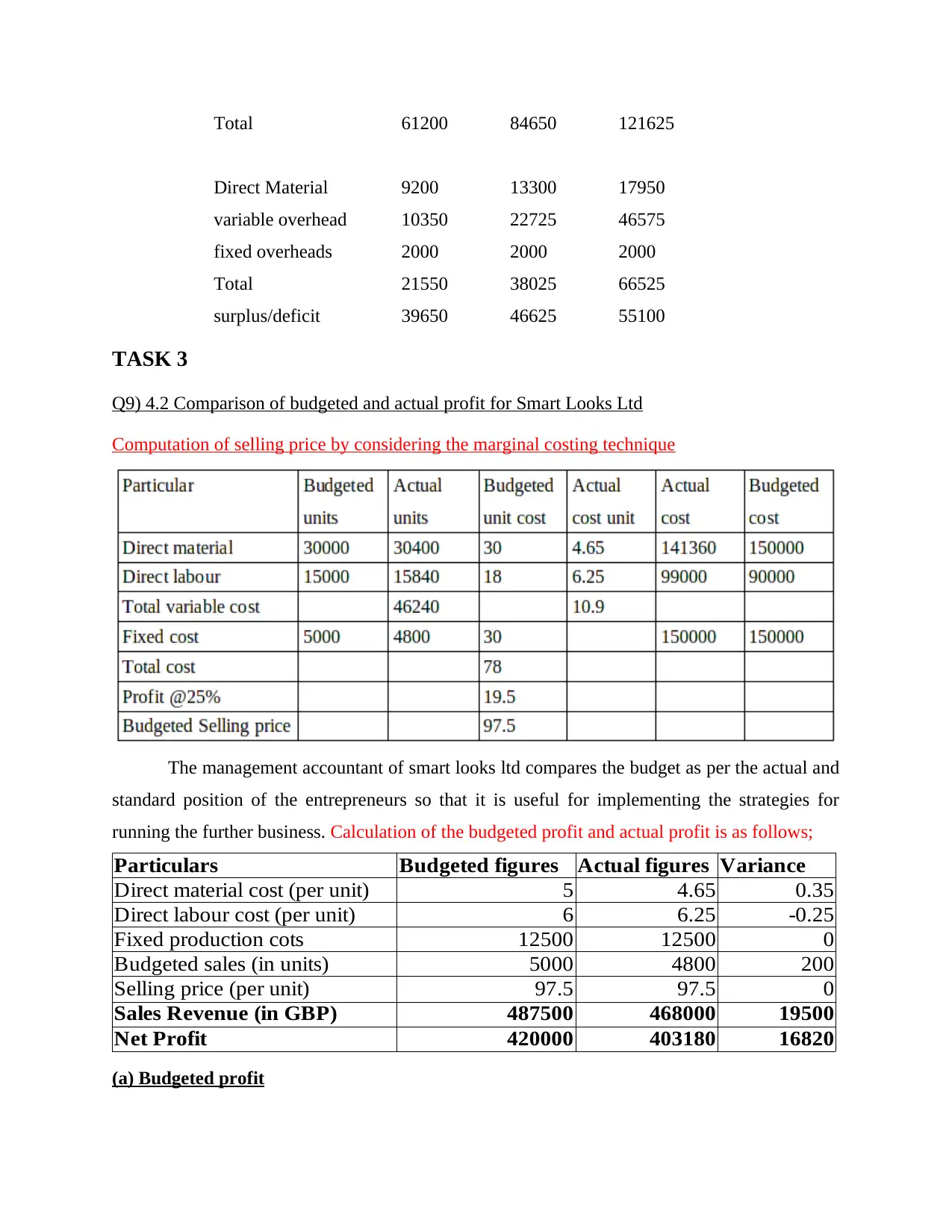
Total 61200 84650 121625
Direct Material 9200 13300 17950
variable overhead 10350 22725 46575
fixed overheads 2000 2000 2000
Total 21550 38025 66525
surplus/deficit 39650 46625 55100
TASK 3
Q9) 4.2 Comparison of budgeted and actual profit for Smart Looks Ltd
Computation of selling price by considering the marginal costing technique
The management accountant of smart looks ltd compares the budget as per the actual and
standard position of the entrepreneurs so that it is useful for implementing the strategies for
running the further business. Calculation of the budgeted profit and actual profit is as follows;
Particulars Budgeted figures Actual figures Variance
Direct material cost (per unit) 5 4.65 0.35
Direct labour cost (per unit) 6 6.25 -0.25
Fixed production cots 12500 12500 0
Budgeted sales (in units) 5000 4800 200
Selling price (per unit) 97.5 97.5 0
Sales Revenue (in GBP) 487500 468000 19500
Net Profit 420000 403180 16820
(a) Budgeted profit
Direct Material 9200 13300 17950
variable overhead 10350 22725 46575
fixed overheads 2000 2000 2000
Total 21550 38025 66525
surplus/deficit 39650 46625 55100
TASK 3
Q9) 4.2 Comparison of budgeted and actual profit for Smart Looks Ltd
Computation of selling price by considering the marginal costing technique
The management accountant of smart looks ltd compares the budget as per the actual and
standard position of the entrepreneurs so that it is useful for implementing the strategies for
running the further business. Calculation of the budgeted profit and actual profit is as follows;
Particulars Budgeted figures Actual figures Variance
Direct material cost (per unit) 5 4.65 0.35
Direct labour cost (per unit) 6 6.25 -0.25
Fixed production cots 12500 12500 0
Budgeted sales (in units) 5000 4800 200
Selling price (per unit) 97.5 97.5 0
Sales Revenue (in GBP) 487500 468000 19500
Net Profit 420000 403180 16820
(a) Budgeted profit
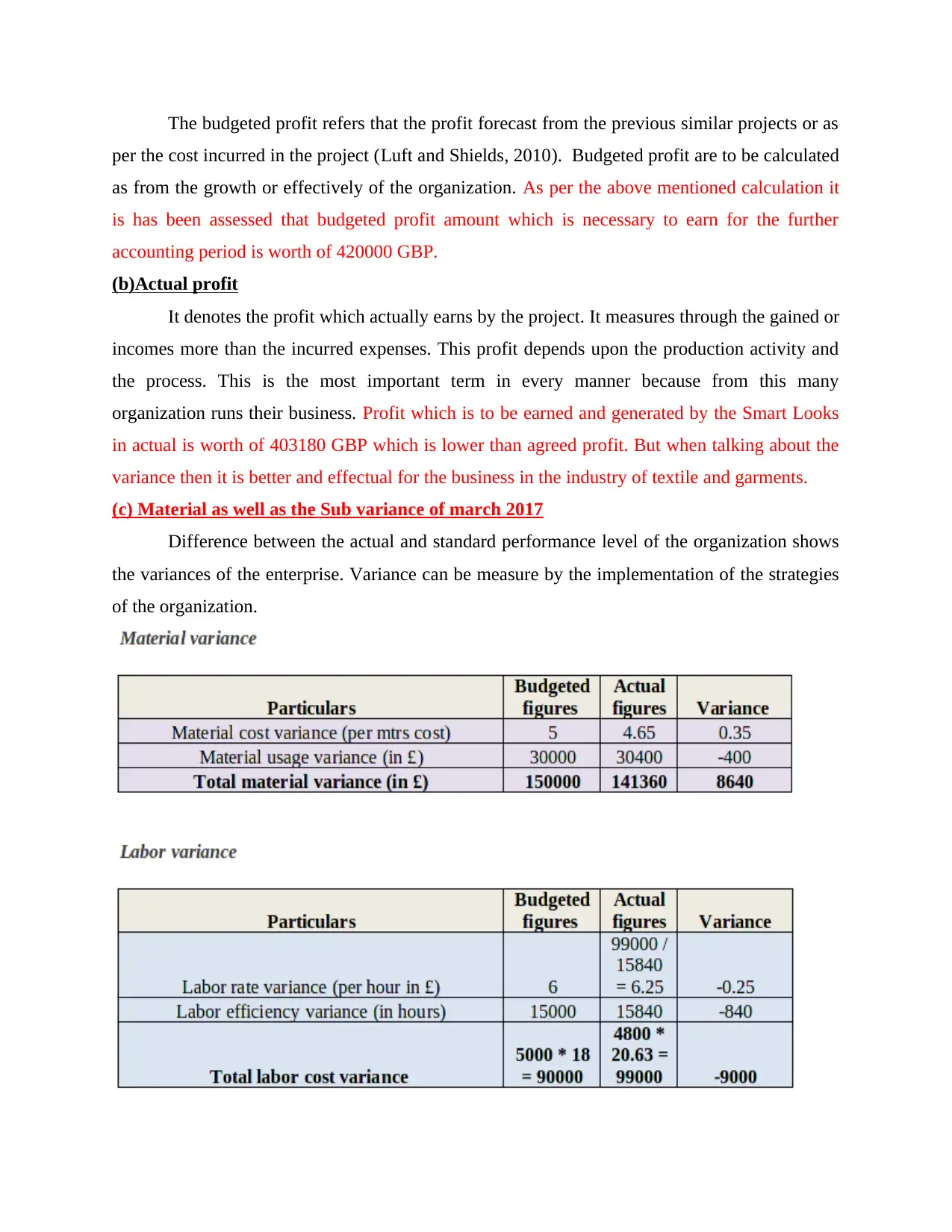
The budgeted profit refers that the profit forecast from the previous similar projects or as
per the cost incurred in the project (Luft and Shields, 2010). Budgeted profit are to be calculated
as from the growth or effectively of the organization. As per the above mentioned calculation it
is has been assessed that budgeted profit amount which is necessary to earn for the further
accounting period is worth of 420000 GBP.
(b)Actual profit
It denotes the profit which actually earns by the project. It measures through the gained or
incomes more than the incurred expenses. This profit depends upon the production activity and
the process. This is the most important term in every manner because from this many
organization runs their business. Profit which is to be earned and generated by the Smart Looks
in actual is worth of 403180 GBP which is lower than agreed profit. But when talking about the
variance then it is better and effectual for the business in the industry of textile and garments.
(c) Material as well as the Sub variance of march 2017
Difference between the actual and standard performance level of the organization shows
the variances of the enterprise. Variance can be measure by the implementation of the strategies
of the organization.
per the cost incurred in the project (Luft and Shields, 2010). Budgeted profit are to be calculated
as from the growth or effectively of the organization. As per the above mentioned calculation it
is has been assessed that budgeted profit amount which is necessary to earn for the further
accounting period is worth of 420000 GBP.
(b)Actual profit
It denotes the profit which actually earns by the project. It measures through the gained or
incomes more than the incurred expenses. This profit depends upon the production activity and
the process. This is the most important term in every manner because from this many
organization runs their business. Profit which is to be earned and generated by the Smart Looks
in actual is worth of 403180 GBP which is lower than agreed profit. But when talking about the
variance then it is better and effectual for the business in the industry of textile and garments.
(c) Material as well as the Sub variance of march 2017
Difference between the actual and standard performance level of the organization shows
the variances of the enterprise. Variance can be measure by the implementation of the strategies
of the organization.
Secure Best Marks with AI Grader
Need help grading? Try our AI Grader for instant feedback on your assignments.
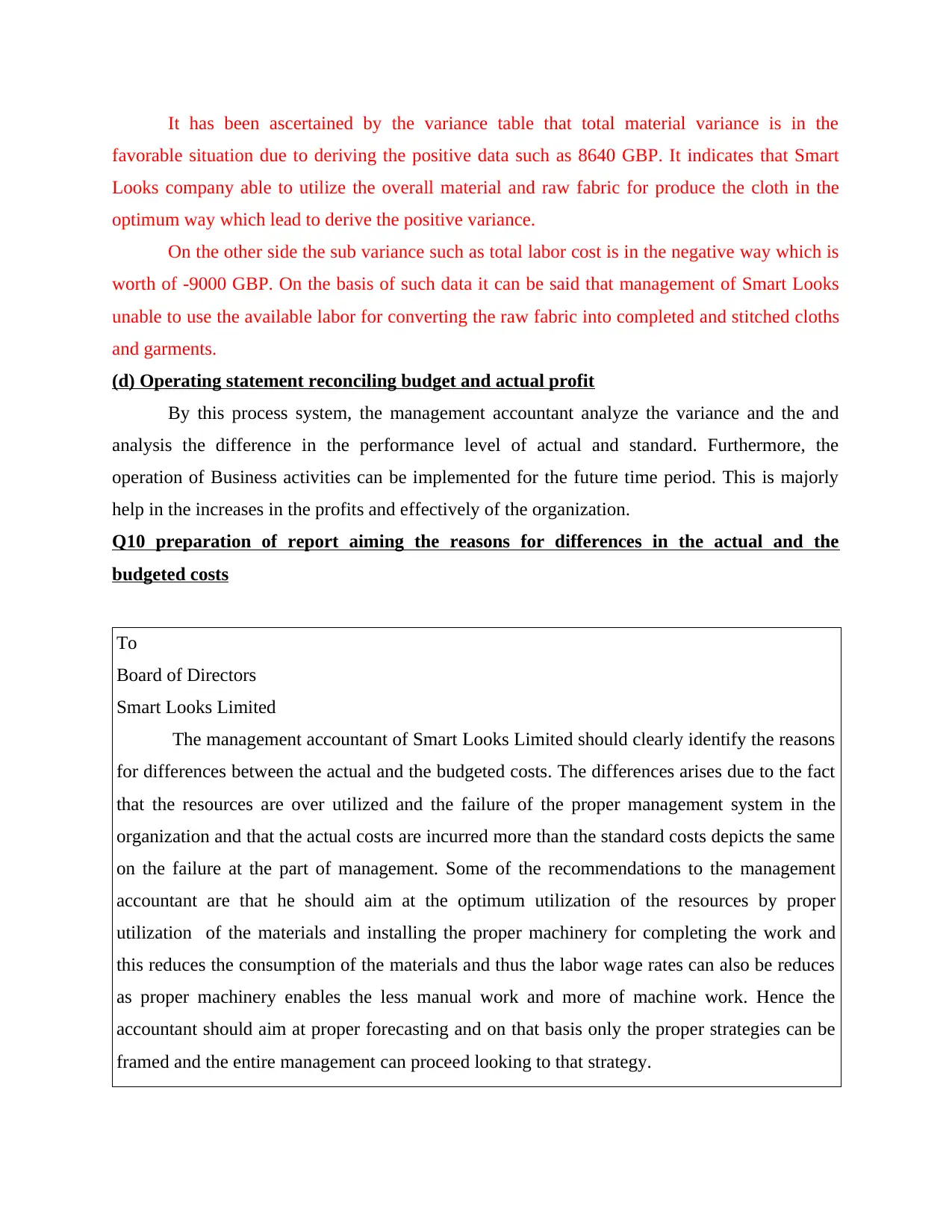
It has been ascertained by the variance table that total material variance is in the
favorable situation due to deriving the positive data such as 8640 GBP. It indicates that Smart
Looks company able to utilize the overall material and raw fabric for produce the cloth in the
optimum way which lead to derive the positive variance.
On the other side the sub variance such as total labor cost is in the negative way which is
worth of -9000 GBP. On the basis of such data it can be said that management of Smart Looks
unable to use the available labor for converting the raw fabric into completed and stitched cloths
and garments.
(d) Operating statement reconciling budget and actual profit
By this process system, the management accountant analyze the variance and the and
analysis the difference in the performance level of actual and standard. Furthermore, the
operation of Business activities can be implemented for the future time period. This is majorly
help in the increases in the profits and effectively of the organization.
Q10 preparation of report aiming the reasons for differences in the actual and the
budgeted costs
To
Board of Directors
Smart Looks Limited
The management accountant of Smart Looks Limited should clearly identify the reasons
for differences between the actual and the budgeted costs. The differences arises due to the fact
that the resources are over utilized and the failure of the proper management system in the
organization and that the actual costs are incurred more than the standard costs depicts the same
on the failure at the part of management. Some of the recommendations to the management
accountant are that he should aim at the optimum utilization of the resources by proper
utilization of the materials and installing the proper machinery for completing the work and
this reduces the consumption of the materials and thus the labor wage rates can also be reduces
as proper machinery enables the less manual work and more of machine work. Hence the
accountant should aim at proper forecasting and on that basis only the proper strategies can be
framed and the entire management can proceed looking to that strategy.
favorable situation due to deriving the positive data such as 8640 GBP. It indicates that Smart
Looks company able to utilize the overall material and raw fabric for produce the cloth in the
optimum way which lead to derive the positive variance.
On the other side the sub variance such as total labor cost is in the negative way which is
worth of -9000 GBP. On the basis of such data it can be said that management of Smart Looks
unable to use the available labor for converting the raw fabric into completed and stitched cloths
and garments.
(d) Operating statement reconciling budget and actual profit
By this process system, the management accountant analyze the variance and the and
analysis the difference in the performance level of actual and standard. Furthermore, the
operation of Business activities can be implemented for the future time period. This is majorly
help in the increases in the profits and effectively of the organization.
Q10 preparation of report aiming the reasons for differences in the actual and the
budgeted costs
To
Board of Directors
Smart Looks Limited
The management accountant of Smart Looks Limited should clearly identify the reasons
for differences between the actual and the budgeted costs. The differences arises due to the fact
that the resources are over utilized and the failure of the proper management system in the
organization and that the actual costs are incurred more than the standard costs depicts the same
on the failure at the part of management. Some of the recommendations to the management
accountant are that he should aim at the optimum utilization of the resources by proper
utilization of the materials and installing the proper machinery for completing the work and
this reduces the consumption of the materials and thus the labor wage rates can also be reduces
as proper machinery enables the less manual work and more of machine work. Hence the
accountant should aim at proper forecasting and on that basis only the proper strategies can be
framed and the entire management can proceed looking to that strategy.
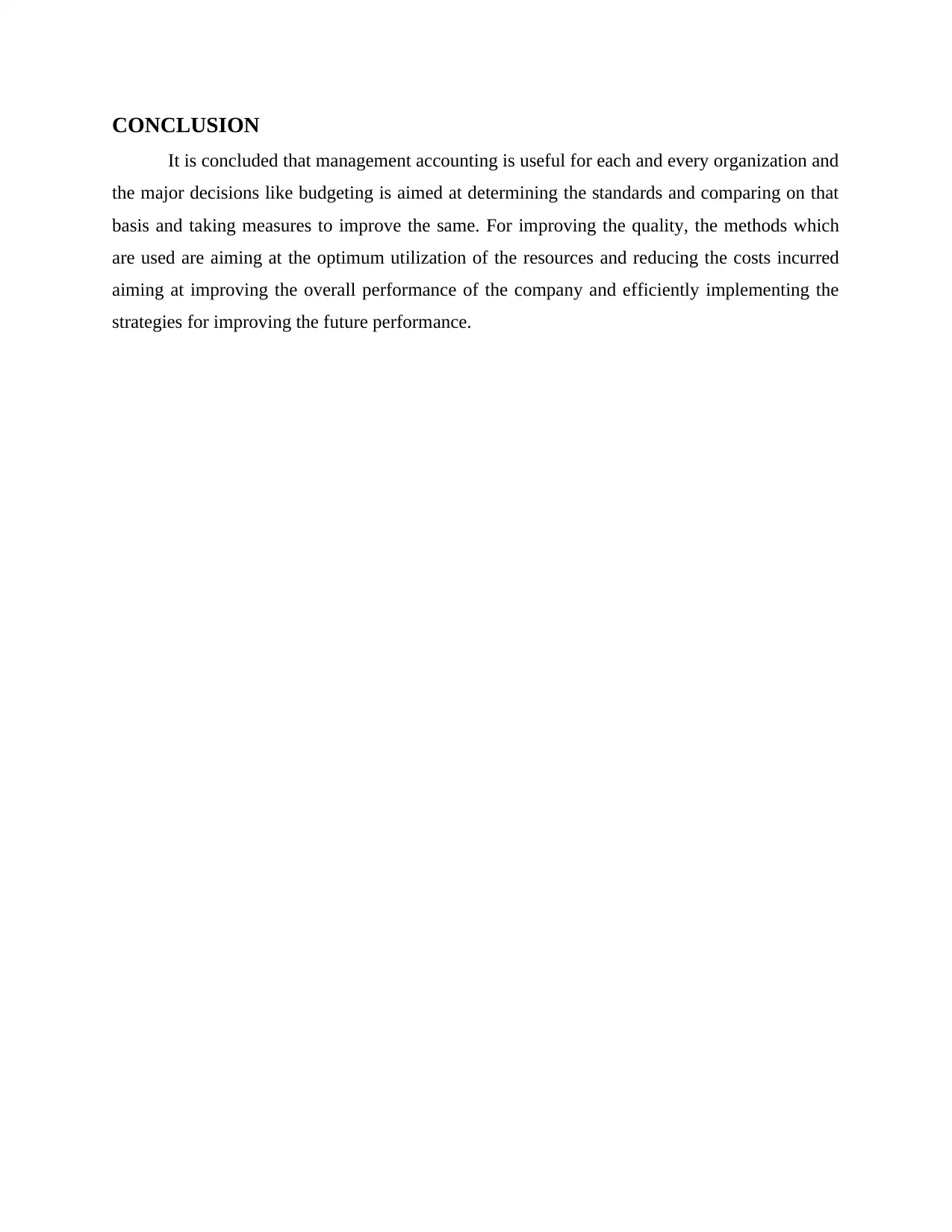
CONCLUSION
It is concluded that management accounting is useful for each and every organization and
the major decisions like budgeting is aimed at determining the standards and comparing on that
basis and taking measures to improve the same. For improving the quality, the methods which
are used are aiming at the optimum utilization of the resources and reducing the costs incurred
aiming at improving the overall performance of the company and efficiently implementing the
strategies for improving the future performance.
It is concluded that management accounting is useful for each and every organization and
the major decisions like budgeting is aimed at determining the standards and comparing on that
basis and taking measures to improve the same. For improving the quality, the methods which
are used are aiming at the optimum utilization of the resources and reducing the costs incurred
aiming at improving the overall performance of the company and efficiently implementing the
strategies for improving the future performance.
1 out of 18
Related Documents
Your All-in-One AI-Powered Toolkit for Academic Success.
+13062052269
info@desklib.com
Available 24*7 on WhatsApp / Email
![[object Object]](/_next/static/media/star-bottom.7253800d.svg)
Unlock your academic potential
© 2024 | Zucol Services PVT LTD | All rights reserved.





